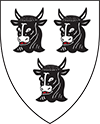Historical Photographs
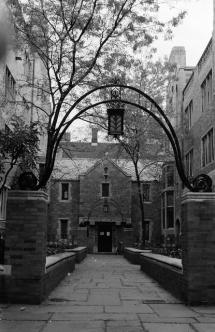 |
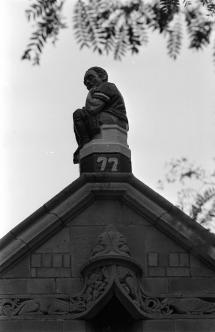 |
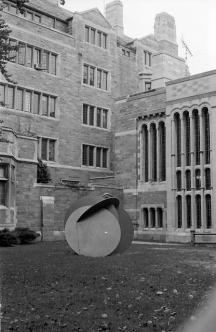 |
| Photos by Harry Itagaki |
How Did Trumbull Get Its Name?
Trumbull College was named for Connecticut Governor Jonathan Trumbull, member of a family who traces its lineage back to the Turnbull family of Scotland. The name Turnbull owes its heraldic origin to the gallantry of a young peasant. In around 1315, a king engaged in a chase was attacked by a bull. Throwing himself before the king, the peasant skillfully seized the animal by the horns. As a reward for saving his life, the king gave the peasant an estate and the name Turnbull. With the name came a coat of arms with three bull heads and the motto Fortuna Favet Audaci, or Fortune Favors the Brave. But how did Turnbull become Trumbull? The corrupted spelling of the name is accounted for by the Scottish custom of rolling the letter r. A scribe recording the word probably mistook the placement of the prominent sound of the letter r. To this day sometimes the name “Turnbull” is prounouced by Scotsmen as “Trumbull.”
In February 2024, Yale released “Yale and Slavery: A History” by David Blight with the Yale and Slavery Research Project. The book is a historical examination that uncovers many pieces of Yale’s ties to slavery in the early period of the university’s 300+ year history. It marks a milestone in the Yale and Slavery Research Project, which was launched in 2020 and is part of ongoing Belonging at Yale efforts to create a stronger community.
The Yale and Slavery Research Project website includes a free digital version of the book, information about the university’s commitment to building a stronger community, a timeline and videos of research findings, a mobile app that provides a self-guided tour of sites associated with Yale’s history and legacy of slavery, and ways for the community to respond.
Heads of College and Deans of Trumbull College
Heads of College
| 1932-1938 | Stanhope Bayne-Jones |
| 1938-1945 | Charles Hyde Warren |
| 1945-1963 | John Spangler Nicholas |
| 1963-1966 | George Deforest Lord |
| 1966-1969 | Ronald Myles Dworkin |
| 1969-1973 | Kai Theodor Erikson |
| 1973-1977 | Robert John Fogelin |
| 1976-1977 | Robert A. Jaeger, acting |
| 1977-1982 | Michael George Cooke |
| 1982-1987 | Frank William Kenneth Firk |
| 1987-1997 | Harry B. Adams |
| 1997-2002 | Janet B. Henrich |
| 2002-2003 | Frederick J. Streets, acting |
| 2003 to 2013 | Janet B. Henrich |
| 2013 to 2023 | Margaret Clark |
| 2023 to present | Fahmeed Hyder |
Deans
| 1963-1965 | Russell Inslee Clark, Jr. |
| 1965-1968 | Edwin Storer Redkey |
| 1968-1971 | Paul Terry Magee |
| 1971-1978 | W. Scott Long |
| 1974-1975 | C. M. Long, acting |
| 1978-1982 | Robert A. Jaeger |
| 1982-1986 | Mary Ramsbottom |
| 1986-1990 | Peter B. MacKeith |
| 1990-1998 | William Di Canzio |
| 1998-2001 | Peter Novak |
| 2001-2004 | Laura King |
| 2004 - 2016 | Jasmina Besirevic-Regan |
| 2016 - present | Surjit Chandhoke |
Arms & Motto
An old device of the Trumbulls of Scotland appears in the arms of the college. The design by Professor Theodore Sizer, M.A. (Hon.) 1931, is adapted from that on the Governor’s original seal which is in the Trumbull Collection in the Yale Art Gallery, the gift of Mrs. Mary Trumbull Compton and Miss Alice Smith Trumbull. (Silver, three bulls’ heads, razed sable.)
“We Must Consult Brother Jonathan”
The phrase is one of endearment between Trumbull and George Washington and has its roots in the Revolutionary War. British General Thomas Gage arrived in Boston, a city on the verge of violence, on May 13, 1774. Given the problems he was inheriting from Royal Governor Thomas Hutchinson, within a week of arriving Gage contacted Connecticut governor Jonathan Trumbull and expressed a “readiness to cooperate” with him “for the good of his Majesty’s service.” When Gage sent Trumbull a request for assistance after the Battles of Lexington and Concord, Trumbull refused and made clear his choice to side with the Patriots. He replied that Gage’s troops would “disgrace even barbarians,” and he accused Gage of “a most unprovoked attack upon the lives and the property of his Majesty’s subjects.” This showed his support for the Revolution. In connection to Yale, On July 6, 1775, along with other officers, the governor of Connecticut commissioned Nathan Hale (B.A. 1773) as a first lieutenant in the newly raised Seventh Regiment.
Trumbull was a friend and advisor of General Washington throughout the revolutionary period, dedicating the resources of Connecticut to the fight for independence. Washington declared him “the first of the patriots.” When Washington was desperate for men or food during the war, he could turn to “Brother Jonathan,” indeed when making key decision he always sought the counsel of Trumbull and said “We must consult Brother Jonathan.”
The phrase “We must Consult Brother Jonathan” appears on the graduation certificates of the college.
Murals & Architecture
Trumbull is slightly more contemporary than other colleges. While in the Memorial Quadrangle (Branford and Saybrook), architect Rogers showed that he was a master in the use of an historical style, In SML and in Trumbull he developed style that had its roots in Gothic but had in it as well an expression of the new methods of construction and a reflection of modern life, what Rogers called “Modern Gothic.” This is well illustrated in the restrained decoration by the sculptor, Lee Lawrie, B.F.A 1910, M.A. 1932. Rogers designed a façade with high corner wings and a continuous midblock arcade in lateral echo of his earlier façade, establishing a pattern of urbanism by imitation that he was to follow with varying degrees of success for some years. Trumbull is built of seam-face granite with limestone trim.
Murals
Most of the decorations on the inside and outside of Trumbull recall life at Yale when John Sterling was an undergraduate.
Civil War
At the side of the first doorway in the Main Court is a Union Soldier, and by the third doorway a Confederate Soldier, symbolic of the War Between the States. This is most likely included in the college because the Civil War ended in 1865, just one year after John Sterling graduated from Yale.
Dining Hall
Over the fireplace in the Dining Hall are the arms of the three universities which conferred degrees on Trumbull – Yale, Harvard, and Edinburgh. Over the door (which leads to the Common Room) at the opposite end of the Dining Hall are the arms of George Washington, Trumbulls close friend and beneath appears “We must consult Brother Jonathan,” a frequent saying of Washington’s by which he was referring to Trumbull’s wise counsel.
College Events & Traditions
Assassins
A “deadly” game that draws shifty eyes all over campus, causing roommates to betray each other and even some Trumbullians to hide in showers. Although unofficially played since the late 1980s, the current incarnation of the Trumbull Assassin game was developed and run by Jon Gruenberg (TC ’95).
Trumbull Crier
Every town has a crier, and so does Trumbull. Every week, the Crier (or Trumcrier) has traditionally shouted from the balcony of the dining hall, “It’s six o’clock in Trumbull College, and all is well!” and made announcements of upcoming events. The first Trumbull Town Crier was Jeremy Monthy (TC ’95), who came up with the concept, made and wore the tricorn hat fitted with bull horns, and began each announcement, “Moo-ye, moo-ye.”
The Trumbulletin
This is Trumbull’s tabloid magazine and the oldest residential college publication at Yale, although it has been waning as of late, with nary an issue in more than two and a half years. The name of the tabloid has actually changed starting as the Trumbulllian, then the Trumbull Times, then the Trumbull Newsletter, then the Trumbulletin.
Rumble in Trumbull
Trumbullians combat with massive foam gloves. Favorite past Rumbles include Jews vs. Gentiles and various competitions among suites. The traditional master vs. dean match, however, has not taken place within the past few years.
Pamplona
Trumbullians celebrate the end of Spring classes with food, music, competitions, and the Running of the Bulls.
Running of the Bulls
A raucous run through Cross Campus and Berkeley College. It usually occurs on the day of Pamplona.
Potty Court Frisbee
A game popular in the 1970s and 1980s played in the Potty Court by two teams of two players each. The general idea was to try to throw a frisbee through the wrought iron arch at the one end of the courtyard from the other arch while the other team’s two players tried to stop it. Defenders could stand on and lean out from the low stone wall next to each arch, and could hang from the arch, but could not touch the walkway under the arch. The attempts alternated between the teams with a scoring system that gave more points for getting the frisbee through the smaller gaps in the arch.
To discourage defenders from committing to defense of the arch before the opponent threw, the thrower could also score a point for a shot that hit the wrought iron fencing next to the arch. The first team to get seven points won. The game included arcane terminology for the different point levels, including a “Grundel” for a more difficult throw. Other than the frisbee, the only other equipment used were leather gloves (optional) for hanging from the sharp wrought iron. A 1970 Yale Daily News article gives an overview of the game and profiles some early enthusiasts.
Cornhole
This has become increasingly popular among Trumbull seniors. The game involves throwing a series of four bean-bags across to the other team’s board, scoring 1 point for each that remains on the board, 3 points if it falls through a hole in the middle. After both teams have gone, the difference between their points is taken, and that difference is awarded to the winning team.
Potty Court Statue
The statue is a likeness of The Thinker by Rodin, but parodies it by placing the thinker on a toilet. The court, Potty Court, is Trumbull’s western most courtyard and is unlike any other at Yale in that the court takes its name from a statue. Trumbull seniors annually paint the Potty Court Statue prior to graduation.
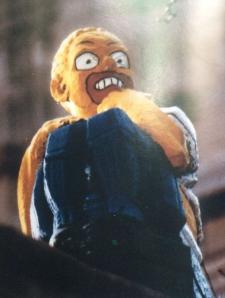 |
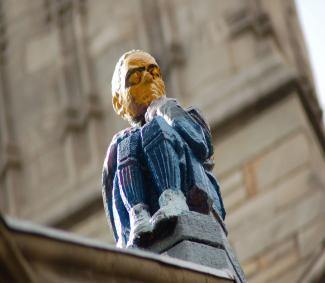 |
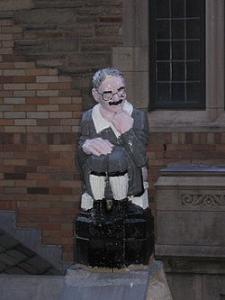 |
Trumbull College Prizes
ROBERT E. LEWIS, JR., MEMORIAL TROPHY. For that Yale College senior who best demonstrates the ideals of athletic leadership and sportsmanship in intercollege competition.
JOHN SPANGLER NICHOLAS CUP. Awarded to that senior who has achieved the highest academic rank.
JOHN SPANGLER NICHOLAS PRIZE (1964). Mrs. Nicholas in memory of her husband, John Spangler Nicholas, Ph.D. 1921. For a junior in Trumbull College of outstanding character and leadership to be selected by the Head and Fellows of the College.
JOHN SPANGLER NICHOLAS SCHOLARSHIP (1964). Friends and associates of Mr. Nicholas. For a student of sterling character and high intellectual ability.
DEAN TEMPLE MEMORIAL TROPHY. Awarded to a senior for distinguished performance in intercollege athletics.
TRUMBULL FELLOWS’ PRIZE. For that student who has done the most to encourage student-faculty relations.
Notable Alumni
Les Aspin (1960, History, the Arts, and Letters)
United States Representative and Secretary of Defense
Susan Bysiewicz (1983, Scholars of the House)
Secretary of State for the State of Connecticut
Anderson Cooper (1989, Political Science)
Anchor of CNN’s Anderson Cooper 360°
Sharon Isbin (1978, Music)
Classical guitarist
David Lempert (1980, Economics & Political Science)
Anthropologist, author, human rights lawyer
Ron Livingston (1989, Theater Studies and Literature)
Actor
Dana Milbank (1990, Political Science)
Political journalist
Allison Silverman (1994, Humanities)
Writer for The Daily Show and The Colbert Report
Oliver Stone (attended)
Academy Award-winning director
Ted Tally (1974, Drama)
Playwright, Academy Award-winning screenwriter

